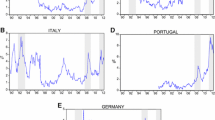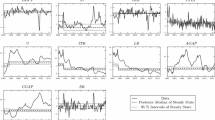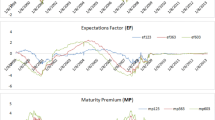Abstract
Evidence in favour of the ability of the term spread to forecast economic growth of the South African economy is non-existent. This could be due to the term spread aggregating information contained in the expected spread and the term premium. To decompose the term spread into its subcomponents, we develop an estimable small open economy new Keynesian dynamic stochastic general equilibrium (SOENKDSGE) model of the inflation targeting South African economy. The SOENKDSGE model is estimated with Bayesian methods over the quarterly period of 2000:01–2014:04. We then use a linear predictive regression framework to analyse the out-of-sample forecasting ability of the aggregate term spread, as well as the expected spread and term premium. Our forecasting results fail to detect forecasting gains from the aggregate term spread and also the term premium, but the expected spread is found to contain important information in forecasting output growth over short- to medium-run horizons, over the period of 2004:01–2014:04, using an in-sample period of 2000:01–2003:04. The results therefore highlight the importance of the forward-looking component of the term spread—the expected spread—in forecasting the output growth of South Africa.

Similar content being viewed by others
Notes
See Mitchell (1913).
Both the Akaike information criterion and the Schwarz information criterion chose a lag length of one for the growth rate of GDP, allowing for a maximum lag of four.
Complete details of the Bai and Perron (2003) test of multiple structural breaks are available upon request from the authors.
For the purposes of this paper, \(L=40\) such that the L-period bonds represent South African 10-year government bonds.
Nominal bond holding \(B_{L,t}\) is deflated by the domestic price level \(P_t^d\), and rendered stationary by removing the common trend as reflected by the permanent technology shock \(z_t\), as follows: \(b_{L,t} = B_{L,t}/(z_t P_t^d)\).
The small open economy model structure largely follows the lines of Adolfson et al. (2007), as it forms the backbone of an operational DSGE model that is used for policy analysis in an inflation targeting central bank. Nevertheless, the model laid out below departs from Adolfson et al. (2007) in three key aspects. Firstly, allowance is made for the fact that on average, inflation in South Africa exceeds that of its trading partners. In the context of the model, this is achieved by assuming that South Africa has a higher steady-state inflation rate. By implication, these differential inflation rates yield a nominal exchange rate depreciation in steady state, as predicted by purchasing parity theory. Secondly, it is assumed that there is no cost channel of monetary policy; hence, firms do not borrow their wage bill. Finally, apart from lump-sum transfers, the role of taxes in the model is disregarded.
The Centre for Economic Research and its Application (CEPREMAP), together with Douglas Laxton’s team at the IMF in Washington, DC, develops and supports the GPM: a large-scale quarterly macroeconomic model of the world economy which consists of approximately 35 countries, aggregated into six regions.
That is, the rate of return on capital has a slightly less than one-to-one relationship with variable capital utilization.
Note that for the sake of consistency with the estimation of the SOENKDSGE model based on the observable variables, we use the repo rate as the measure of the short-term rate of interest instead of the three-month Treasury Bill rate, while decomposing the term spread. We do not expect our results to be affected by such a choice, given that the repo rate and the three-month Treasury bill rate virtually comove and share a (positive) correlation of 0.94, which is significant at 1% level of significance.
Bernanke (2006), in his 2006 address to The Economic Club of New York, cited the narrowing of the term premium as having a stimulative impact on economic activity rather than indicative of an expected decline in economic activity. While both practitioners and academics hold true to the negative correlation between the term premium and economic activity, there is more ambiguity on its predictive power for forecasting economic activity.
A comparison of out-of-sample forecasts for output growth from this current DSGE model which incorporates the term structure relative to the one that does not, showed that our DSGE framework consistently predicted output growth better over two to eight quarters ahead, with the exception of the first quarter. Complete details of these results are available upon request from the authors.
Similar results were also obtained from the in-sample analysis, with only ES showing predictive power. Complete details of these results are available upon request from the authors.
Complete details of the NP unit root tests are available upon request from the authors.
As far as the in-sample is concerned, we observed predictability for all the three first-differenced predictors, with ES producing the strongest prediction, followed by TS and TP.
This line of thinking was further vindicated when we could not detect out-of-sample forecasting gains from the predictive regression model which contained both the expected spread and term premium simultaneously. Complete details of these results are available upon request from the authors.
Based on the suggestions of an anonymous referee, we also used a nonlinear framework, namely the quantiles-based version of the linear predictive regression used in our paper. In general, our results were in line with those obtained under the linear model, in the sense that the expected spread is found to be a stronger predictor than the overall term spread and the term premium, and that too around the median of the conditional distribution of the growth rates, rather than the quantiles of 0.25 and 0.75, capturing recessions and expansions, respectively. We have refrained from presenting these results formally in the paper, because tests of nonlinearity and slope equality across quantiles did not find any evidence in favour of the quantile (i.e. nonlinear) model over the linear framework we have used in the paper. However, complete details of these results are available upon request from the authors.
References
Adolfson M, Laséen S, Lindé J, Villani M (2007) Bayesian estimation of an open economy DSGE model with incomplete pass-through. J Int Econ 72(2):481–511
Adolfson M, Laséen S, Lindé J, Villani M (2008) Evaluating an estimated new Keynesian small open economy model. J Econ Dyn Control 32:2690–2721
Adrian T, Crump R, Moench E (2012) Pricing the term structure with linear regressions. J Financ Econ 110(1):110–138
Ait-Sahalia Y (2008) Closed-form likelihood expansions for multivariate diffusions. Ann Stat 36:906–937
Ait-Sahalia Y, Kimmel R (2010) Estimating affine multifactor term structure models using closed-form likelihood expansions. J Financ Econ 98:113–144
Alpanda S, Kotze K, Woglom G (2010a) The role of the exchange rate in a New Keynesian DSGE model for the South African economy. S Afr J Econ 78(2):170–191
Alpanda S, Kotze K, Woglom G (2010b) Should central banks of small open economies respond to exchange rate fluctuations? The case of South Africa. Economic Research Southern Africa, No. 174
Amisano G, Tristani O (2008) A DSGE model of the term structure with regime shifts. European Central Bank, Germany
Andrés J, López-Salido JD, Nelson E (2004) Tobin’s imperfect asset substitution in optimizing general equilibrium. J Money Credit Bank 36(4):665–690
Ang A, Piazzesi M (2003) A no-arbitrage vector autoregression of term structure dynamics with macroeconomic and latent variables. J Monet Econ 50:745–787
Bai J, Perron P (2003) Computation and analysis of multiple structural change models. J Appl Econ 18(1):1–22
Balcilar M, Gupta R, Kotze K (2015) Forecasting macroeconomic data for an emerging market with a nonlinear DSGE model. Econ Model 44(1):215–228
Balcilar M, Gupta R, Kotze K (2017) Forecasting South African macroeconomic variables with a Markov-switching small open-economy dynamic stochastic general equilibrium model. Empir Econ 53(1):117–135
Bernanke B (2006) Reflections on the yield curve and monetary policy. Presented before the Economic Club of New York
Campbell J (2008) Viewpoint: estimating the equity premium. Can J Econ 41:1–21
Chinn M, Kucko K (2015) The predictive power of the yield curve across countries and time. Int Finance 18(2):129–156
Christensen J, Diebold F, Rudebusch G (2010) The affine arbitrage-free class of Nelson–Siegel term structure models. J Econ 164(1):4–20
Clark TE, McCracken MW (2001) Tests for equal forecast accuracy and encompassing for nested models. J Econ 105:85–110
Clark TE, McCracken MW (2005) Evaluating direct multi-step forecasts. Federal Reserve Bank of Kansas City, RWP 01-14. https://www.kansascityfed.org/Publicat/Reswkpap/PDF/rwp01-14.pdf. Accessed 9 July 2015
Clay R, Keeton G (2011) The South African yield curve as a predictor of economic downturns: an update. Afr Rev Econ Finance 2(2):167–193
Collin-Dufresne P, Goldstein R (2002) Do bonds span the fixed income markets? Theory and evidence for unspanned stochastic volatility. J Finance 57(4):1685–1730
Collin-Dufresne P, Goldstein R, Jones C (2008) Identification of maximal affine term structure models. J Finance 63(2):743–795
Collin-Dufresne P, Goldstein R, Jones C (2009) Can the volatility of interest rates be extracted from the cross section of bond yields? An investigation of unspanned stochastic volatility. J Financ Econ 94(1):47–66
Creal D, Wu J-C (2015) Estimation of affine term structure models with spanned or unspanned stochastic volatility. J Econ 185:60–81
De Graeve F, Emiris M, Wouters R (2009) A structural decomposition of the US yield curve. J Monet Econ 56(4):545–559
de Los Diez, Rios A (2015) A new linear estimator for Gaussian dynamic term structure models. J Bus Econ Stat 33(2):282–295
Dewachter H, Iania L, Lyrio M (2012) Information in the yield curve: a macro-finance approach. J Appl Econ 29:42–64
Diebold F, Rudebusch G (2013) Yield curve modeling and forecasting: the dynamic Nelson–Siegel approach. Princeton University Press, Princeton
Doh T (2008) Estimating a structural macro finance model of the term structure. Federal Reserve Bank of Kansas City, Kansas
du Plessis S, Smit B, Steinbach R, (2014) A medium scale DSGE model of the South African economy. South African Reserve Bank Working Paper 14/04
Duffee G (2002) Term premia and interest rate forecasts in affine models. J Finance 57(1):405–443
Duffee GR (2013) Chapter 13—bond pricing and the macroeconomy. Vol. 2 of Handbook of the Economics of Finance. Elsevier, pp. 907 – 967. http://www.sciencedirect.com/science/article/pii/B9780444594068000135. Accessed 9 July 2015
Eijffinger S, Schaling E, Verhagen W (2000) The term structure of interest rates and inflation forecast targeting. CEPR Discussion Paper No. 2375
Estrella A (2005) Why does the yield curve predict output and inflation? Econ J 115:722–744
Estrella A, Mishkin FS (1995) Predicting U.S. recessions: Financial Variables as Leading Indicators. NBER Working Paper No. 5279
Estrella A, Mishkin FS (1996) The yield curve as a predictor of U.S. recessions. Federal Reserve Bank of. Current Issues in Economics and Finance, vol 2., New York, pp 1–6
Estrella A, Mishkin FS (1998) Predicting U.S. recessions: financial variables as leading indicators. Rev Econ Stat 80(1):45–61
Gali J, Monacelli T (2005) Monetary policy and exchange rate volatility in a small open economy. Rev Econ Stud 72:707–734
Gupta R, Hartley F (2013) The role of asset prices in forecasting inflation and output in South Africa. J Emerg Mark Finance 12(3):239–291
Gupta R, Steinbach R (2013) Forecasting key macroeconomic variables of the South African economy: a small open economy New Keynesian DSGE-VAR model. Econ Model 33(1):19–33
Gurkaynak R, Wright J (2005) Macroeconomics and the term structure. J Econ Lit 50(2):331–367
Hamilton J, Kim D (2002) A re-examination of the predictability of the yield spread for real economic activity. J Money Credit Bank 34(2):340–360
Hamilton J, Wu J (2012) Identification and estimation of Gaussian affine term structure models. J Econ 168(2):315–331
Hamilton J, Wu J (2014) Testable implications of affine term structure models. J Econ 178:231–242
Hollander H, Gupta R, Wohar ME (2018) The impact of oil shocks in a small open economy New-Keynesian dynamic stochastic general equilibrium model for an oil-importing country: The case of South Africa. Emerg Mark Finance Trade 1–26. https://doi.org/10.1080/1540496X.2018.1474346
Ireland PN (2015) Monetary policy, bond risk premia, and the economy. J Monet Econ 76:124–140
Joslin S, Singleton K, Zhu H (2011) A new perspective on Gaussian affine term structure models. Rev Financ Stud 27:926–970
Justiniano A, Preston B (2010) Monetary policy and uncertainty in an empirical small open-economy model. J Appl Econ 25(1):93–128
Kessel R (1965) The cyclical behavior of the term structure of interest rates. National Bureau of Economic Research Occasional Papers 91
Khomo MM, Aziakpono MJ (2007) Forecasting recessions in South Africa: a comparison of the yield curve and other economic indicators. S Afr J Econ 75(2):194–212
Kim D, Orphanides A (2012) Term structure estimation with survey data on interest rate forecasts. J Financ Quant Anal 47(1):241–272
Lucas R (1976) Econometric policy evaluation: a critique. In: Brunner K, Meltzer A (eds) The phillips curve and labor markets. American Elsevier, New York
Martínez-García E, Vílan D, Wynne M (2012) Bayesian estimation of NOEM models: identification and inference in small sample. Adv Econ 28:137–199
McCracken MW (2007) Asymptotics for out-of-sample of Granger causality. J Econ 140(2):719–752
Medina JP, Soto C (2007) Copper price, fiscal policy and business cycle in Chile. Working Papers Central Bank of Chile 458
Medina JP, Soto C (2014) Commodity price shocks and imperfectly credible macroeconomic policies in commodity-exporting small open economies. IMF Working Papers 14/33
Mishkin F (2007) The economics of money, banking, and financial markets. Pearson Education, New York
Mitchell W (1913) Business cycles. University of California Press, Berkeley
Moolman E (2002) The term structure as a predictor of recessions. Stud Econ Econ 26:(3)
Moolman E (2004) A Markov switching regime model of the South African business cycle. Econ Model 21(4):631–646
Nel H (1996) The term structure of interest rates and economic activity in South Africa. S Afr J Econ 64:(3)
Ng S, Perron P (2001) Lag length selection and the construction of unit root tests with good size and power. Econometrica 69(6):1519–1554
Piazzesi M (2010) Affine term structure models. In: Ait-Sahalia Y, Hansen L (eds) Handbook of financial econometrics. Elsevier, New York
Plakandaras V, Gogas P, Theophilos P, Gupta R (2016) The term premium as a leading macroeconomic indicator. International Review of Economics and Finance. Department of Economics, University of Pretoria, Working Paper No. 2016-13
Rapach DE, Wohar ME, Rangvid J (2005) Macro variables and international stock return predictability. Int J Forecast 21:137–166
Rosenberg JV, Maurer S (2008) Signal or noise? implications of the term premium for recession forecasting, economic policy review. Federal Reserve Bank of New York, Kansas, pp 1–11
Rudebusch G, Sack B, Swanson E (2007) Macroeconomic implications of changes in the term premium. Fed Reserve Bank St. Louis Rev 89(4):241–269
Smets F, Wouters R (2003) An estimated dynamic stochastic general equilibrium model of the Euro area. J Eur Econ Assoc 1(5):1123–1175
Smets F, Wouters R (2007) Shocks and frictions in US business cycles: a Bayesian approach. Am Econ Rev 97(3):586–606
Steinbach MR (2014) Essays on dynamic macroeconomics. Ph.D. thesis, Stellenbosch University. http://hdl.handle.net/10019.1/86196. Accessed 9 July 2015
Steinbach M, Mathuloe P, Smit B (2009) An open economy New Keynesian DSGE model of the South African economy. S Afr J Econ 77(2):207–227
Thompson K, van Eyden R, Gupta R (2015) Testing the out-of-sample forecasting ability of a financial conditions index for South Africa. Emerg Mark Finance Trade 51(3):486–501
Tobin J (1958) Liquidity preference as behavior towards risk. Rev Econ Stud 25(2):65–86
Tobin J (1969) A general equilibrium approach to monetary theory. J Money Credit Bank 1(1):15–29
Tobin J (1982) Money and finance in the macroeconomic process. J Money Credit Bank 14(2):171–204
Wheelock D, Wohar M (2009) Can the term spread predict output growth and recessions? A survey of the literature. Fed Reserve Bank St. Louis Rev 91(5):419–440
Zagaglia P (2013) Forecasting long-term interest rates with a general-equilibrium model of the Euro area: What role for liquidity services of bonds? Asia-Pac Financ Mark 20:383–430
Author information
Authors and Affiliations
Corresponding author
Additional information
We would like to thank two anonymous referees for many helpful comments. However, any remaining errors are solely ours.
A The linearized model
A The linearized model
1.1 Households
Optimal L-period bond holdings, \(\hat{b}_{L,t}\)
Money holdings, \(\hat{m}_t\)
Wage setting (real) \(\hat{w}_{t}\)
Consumption Euler equation, \(\hat{c}_{t}\)
Investment Euler equation, \(\hat{i}_{t}\)
Price of installed capital, \(\hat{P}^k_{t}\)
Capital’s law of motion, \(\hat{k}_{t}\)
Capital utilization, \(\hat{u}_{t}\)
Capital services, \(\hat{k}^s_{t}\)
Optimal 1-period asset holdings, \(\hat{\psi }^z_{t}\)
Exchange rate’s modified UIP condition, \(\hat{S}_{t}\)
1.2 Firms
1.2.1 Domestic goods
Production, \(\hat{y}_{t}\)
Rental rate of capital, \(\hat{r}^k_{t}\)
Real marginal cost, \(\hat{mc}^{d}_{t}\)
Price setting, \(\hat{\pi }^{d}_{t}\)
1.2.2 Imported goods
Price setting: imported consumption goods, \(\hat{\pi }^{m,c}_{t}\)
Marginal cost: imported consumption goods, \(\hat{mc}^{m,c}_{t}\)
Price setting: imported investment goods, \(\hat{\pi }^{m,i}_{t}\)
Marginal cost: imported investment goods, \(\hat{mc}^{m,i}_{t}\)
1.2.3 Exported goods
Price setting: exported goods, \(\hat{\pi }^{x}_{t}\)
Marginal cost: exported goods, \(\hat{mc}^{x}_{t}\)
1.3 Government
Liabilities, \(\hat{\ell }_{t}\)
Expenditure’s budget constraint, \(\hat{g}_t\)
Taxation, \(\hat{\tau }_{t}\)
1.4 The Central Bank
Interest rate policy rule, \(\hat{R}_{t}^{}\)
where CPI inflation is given by
1.5 Relative prices, \(\hat{\gamma }_{t}^{i,j}\)
Consumption and investment goods
Imported consumption and investment goods
Export goods
Domestic–foreign goods relative price
Real exchange rate
1.6 Market clearing
Domestic goods market, \(\hat{y}_{t}\)
Net foreign assets, \(\hat{a}_{t}\)
1.7 AR(1) shock processes
where
Rights and permissions
About this article
Cite this article
Gupta, R., Hollander, H. & Steinbach, R. Forecasting output growth using a DSGE-based decomposition of the South African yield curve. Empir Econ 58, 351–378 (2020). https://doi.org/10.1007/s00181-018-1607-4
Received:
Accepted:
Published:
Issue Date:
DOI: https://doi.org/10.1007/s00181-018-1607-4
Keywords
- Structural decomposition
- Term spread
- DSGE
- Predictive regression framework
- Forecasting output growth
- South Africa




